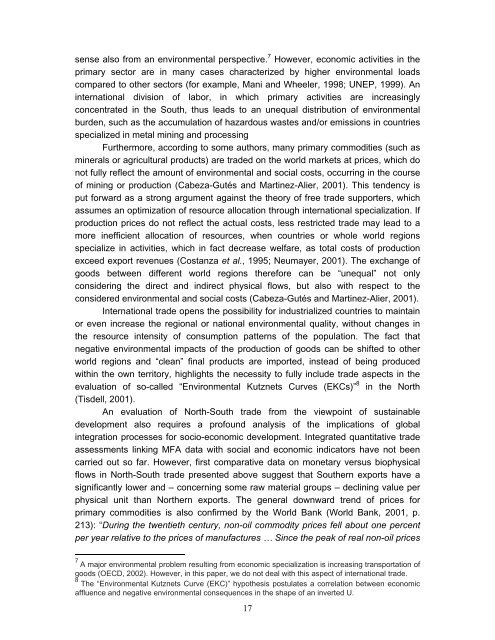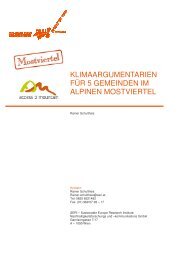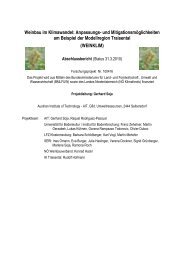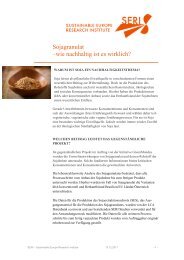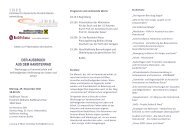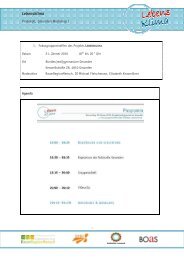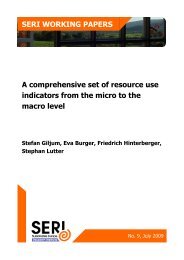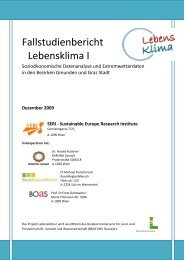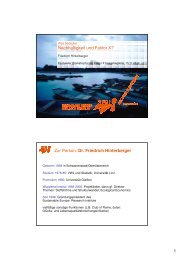Download PDF - Sustainable Europe Research Institute
Download PDF - Sustainable Europe Research Institute
Download PDF - Sustainable Europe Research Institute
Create successful ePaper yourself
Turn your PDF publications into a flip-book with our unique Google optimized e-Paper software.
sense also from an environmental perspective. 7 However, economic activities in the<br />
primary sector are in many cases characterized by higher environmental loads<br />
compared to other sectors (for example, Mani and Wheeler, 1998; UNEP, 1999). An<br />
international division of labor, in which primary activities are increasingly<br />
concentrated in the South, thus leads to an unequal distribution of environmental<br />
burden, such as the accumulation of hazardous wastes and/or emissions in countries<br />
specialized in metal mining and processing<br />
Furthermore, according to some authors, many primary commodities (such as<br />
minerals or agricultural products) are traded on the world markets at prices, which do<br />
not fully reflect the amount of environmental and social costs, occurring in the course<br />
of mining or production (Cabeza-Gutés and Martinez-Alier, 2001). This tendency is<br />
put forward as a strong argument against the theory of free trade supporters, which<br />
assumes an optimization of resource allocation through international specialization. If<br />
production prices do not reflect the actual costs, less restricted trade may lead to a<br />
more inefficient allocation of resources, when countries or whole world regions<br />
specialize in activities, which in fact decrease welfare, as total costs of production<br />
exceed export revenues (Costanza et al., 1995; Neumayer, 2001). The exchange of<br />
goods between different world regions therefore can be “unequal” not only<br />
considering the direct and indirect physical flows, but also with respect to the<br />
considered environmental and social costs (Cabeza-Gutés and Martinez-Alier, 2001).<br />
International trade opens the possibility for industrialized countries to maintain<br />
or even increase the regional or national environmental quality, without changes in<br />
the resource intensity of consumption patterns of the population. The fact that<br />
negative environmental impacts of the production of goods can be shifted to other<br />
world regions and “clean” final products are imported, instead of being produced<br />
within the own territory, highlights the necessity to fully include trade aspects in the<br />
evaluation of so-called “Environmental Kutznets Curves (EKCs)” 8 in the North<br />
(Tisdell, 2001).<br />
An evaluation of North-South trade from the viewpoint of sustainable<br />
development also requires a profound analysis of the implications of global<br />
integration processes for socio-economic development. Integrated quantitative trade<br />
assessments linking MFA data with social and economic indicators have not been<br />
carried out so far. However, first comparative data on monetary versus biophysical<br />
flows in North-South trade presented above suggest that Southern exports have a<br />
significantly lower and – concerning some raw material groups – declining value per<br />
physical unit than Northern exports. The general downward trend of prices for<br />
primary commodities is also confirmed by the World Bank (World Bank, 2001, p.<br />
213): “During the twentieth century, non-oil commodity prices fell about one percent<br />
per year relative to the prices of manufactures … Since the peak of real non-oil prices<br />
7 A major environmental problem resulting from economic specialization is increasing transportation of<br />
goods (OECD, 2002). However, in this paper, we do not deal with this aspect of international trade.<br />
8 The “Environmental Kutznets Curve (EKC)” hypothesis postulates a correlation between economic<br />
affluence and negative environmental consequences in the shape of an inverted U.<br />
17


